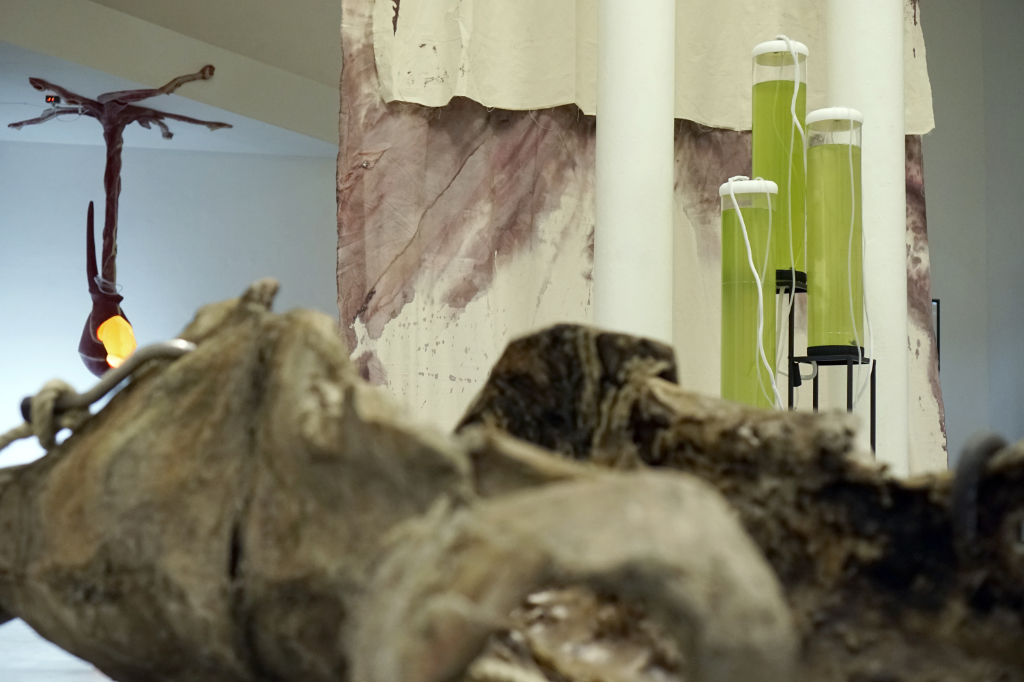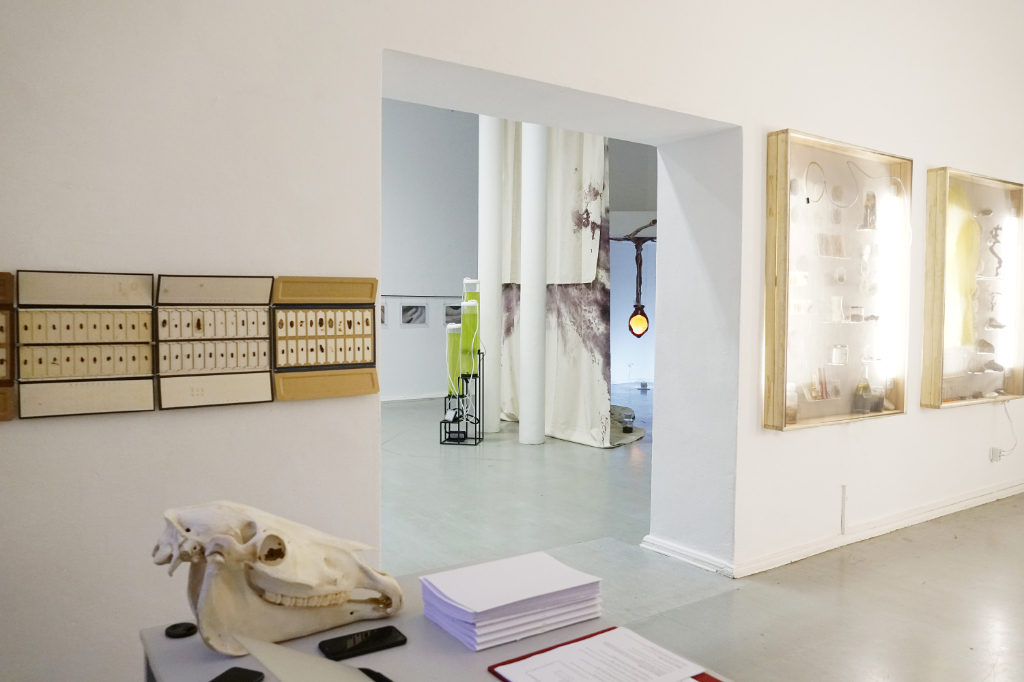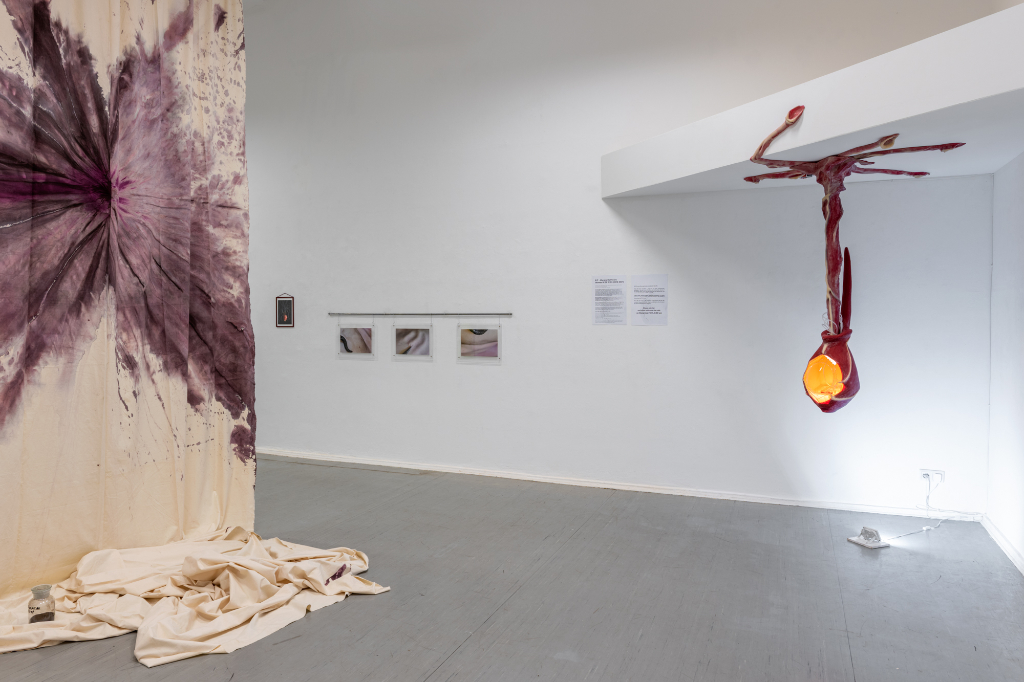Text by Lyndsey Walsh

Responding to the uses (and potential misuses) of biotechnology and the interwoven socio-political, biological, and cognitive connotations of their implementation, Membranes Out of Order is an exhibition examining the multiplicities of perspectives and lenses of engagement emerging from the umbrella term of “bioart”. Featuring the work of three berlin-based artists, Karolina Żyniewicz, Theresa Schubert, and Margherita Pevere, alongside international guests, the programme situated at the Kunstquartier Bethanien sets out to explore membranes both as material and metaphor, as well as the uncertainty, potential failures, surprises, and disobediences that emerge when working with living materials.
The exhibition concept emerged from Pevere and Schubert’s connection as studio mates and their shared artistic interest in artistic research and experimentation. Through being studio mates, Pevere and Schubert have witnessed each other’s works at various stages of development and production. Pevere reveals we’ve seen each other mostly work in boxes, disassembled, in prototypes, and this is another part of an artwork’s life. What you see in exhibitions is fantastic with its white lighting, maybe on a pedestal or hanging or on a shelf, but this is a short movement in an artwork’s life.
Pevere and Schubert’s interests in artistic research overlap with Żyniewicz, who has been undergoing PhD studies during the same time as Pevere and also shares with her the process of researching, writing, and forming a critical dialogue together.
In the process of creating the exhibition, the artists have also collaboratively curated the exhibition together, thereby analysing the overlaps in individual practices and meeting each other in their varying positions. Diving into their collections and the body of their work, they aim to share the research done into each other’s practices. Collectively the artworks and collection of objects and materials form a dialogue between the artists’ individual perspectives, reflecting on their years of work and production that has culminated in the emergence of Membranes Out of Order.
As part of the curatorial programme, Membranes Out of Order offers artist talks and talks by invited guests and experts Regine Rapp, co-founder and co-director of Art Laboratory Berlin, Paweł Golik, who is the Professor for Genetics and Molecular Biology at the University of Warsaw, and Marianna Szczygielska who is a philosopher of science at the Czech Academy of Sciences and Bard College Berlin. The exhibition concludes with a finnissage on the 8th of January.
In addition to the curatorial programme, events, and artworks, Membranes Out of Order also features an accessibility concept for the visually impaired that has been created in collaboration with the Deutscher Blinden- und Sehbehindertenverband e. V. (DBSV). This accessibility concept includes low-barrier communication approaches, including tactile objects, descriptions in Braille, and audio descriptions. Żyniewicz and her assistant Liza Vasilieva also offer in-person guided tours in shifts.
This exhibition is the first time that a project at the Kunstquartier Bethanien has dedicated itself solely to “bioart”. The show inhabits six exhibition rooms of its Projektraum and fills them with both artworks from the artists as well as research materials, artefacts, and more. The exhibition’s first room that the audience enters is what the artists call the “obsession room”, paralleling a cabinet of curiosities or Wunderkammer.
The room is one of the multiple entry points into the artistic research underlying Pevere, Schubert, and Żyniewicz’s works and practices. The obsession room sets an inquisitive tone for exploration and an immersion into the wide reaches of research, documentation, and specimen collection that takes place in the artists’ creative practices.




Further along in the space, the artists also have a number of their own artworks on display. These artworks explore various themes and important, but sometimes controversial, socio-political topics. For example, Theresa Schubert’s mEat me questions the mass production and the future of the production of meat for consumption by having meat grown from her own cells to be consumed, Pevere’s series Wombs explores the more-than-human perspectives of sexuality and hormonal contraception, and Żyniewicz’s safe suicide contemplates notions of autonomy and the right to end life through the artist’s preparation to end the life of her own cells that were grown in the laboratory.
However, the central connecting thread between the artists’ works focuses on their use of living materials, references, and explorations of living systems. The artworks featured have also been reinterpreted to exist within a cohesive dialogue through the metaphor and connections with the curatorial theme of membranes.
The presence of membranes when working with living materials is ubiquitous. It forms the outer shell of an organism or living entity and mediates the boundaries of what exists inside versus outside. The most common membrane that comes to mind is that of the skin, which forms the interface between the body and its outside environment.
Jens Hausers’ term “sk-interfaces”, defined in depth in Hauser’s 2008 edited book entitled Sk-Interfaces: Exploding Borders- Creating Membranes in Art, Technology and Society, explores the permeability of these membranes and skin, as well as how skin itself is also an interface for the disciplines of art, science, philosophy and social culture to intersect. Membranes Out of Order builds off of this similar conceptual framework.
Pevere describes membranes “as a site of encounter”, one that is both a metaphor but also further explains that the curatorial theme of membranes “comes from our very real experience of working with membranes like skin cellular membranes, bacterial membranes, bacterial cellulose, membranes across disciplinary fields, and membrane as something that separates but also keeps in communication, keeps in exchange, like skin—a broader membrane on our body or blood vessels.”
Żyniewicz adds that it is important to understand membranes as borders, which are flexible, so we can stretch them. We can sometimes be violent to them and cut them and cross them. It is also about different manipulations of membranes, while Schubert offers up the perspective that membranes are a shape-defining border but also a milieu of multitudes.
The artists’ out-of-order approach to working and dealing with membranes in their practices and artworks highlights the ruptures that can occur when membranes and boundaries are transgressed, as well as when life persists with its unpredictability and can resist the confines of a border or boundary.
Alongside the featured artworks, the exhibition seeks to reveal the materials, objects, and what often remains hidden from public audiences from these artists’ creative process and research. For the first time, many of the artists’ drawings, laboratory journals, photographs, and other objects from the artists’ collections are displayed throughout the exhibition. By showing what Żyniewicz calls the body of the process, another border is crossed between what remains in the artists’ archives and collections and what can inhabit the exhibition space.
When selecting what to share and what to keep for themselves, Żyniewicz recalled that she focused on the similarities between their works, while Pevere highlighted the agreed importance they wanted to place on expanding on the research aspects of their work.
The final selection of pieces explores the implications of more-than-human relations, and the ethical quandaries brought about by biotechnological advancements. Membranes Out of Order sets out to take a closer look at the research and collection of materials that are produced in creative explorations with living matter and materials to both reveal what goes on inside of a membrane but also the meanings made by them.






